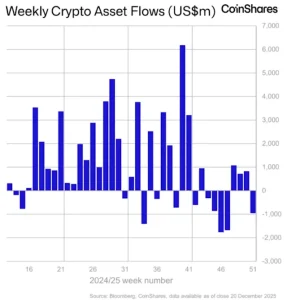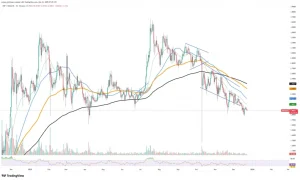Bitcoin’s Wave 5 Correction: Why a Drop to Rs. 77 Lakh Could Redefine the Market Cycle

Bitcoin’s recent price downturn has stirred concern among traders and long-term investors alike. Analysts observing market structures through Elliott Wave theory predict that Bitcoin could enter its fifth corrective wave, potentially pulling prices down to around $94,000 (approximately Rs. 77 lakh). Far from signaling a collapse, such a retracement could serve as a vital structural reset—rebalancing overbought conditions, cooling speculative fervor, and paving the way for a more sustainable long-term rally. Understanding why this correction matters is essential to grasping the broader implications for both retail and institutional participants in the evolving crypto landscape.
The Anatomy of Bitcoin’s Current Decline
The ongoing slide in Bitcoin’s price is being interpreted by technical analysts as part of a larger Elliott Wave cycle—an established model used to predict market psychology through recurring wave patterns. After months of strong upward movement driven by institutional accumulation and ETF-related optimism, Bitcoin now appears to be entering Wave 5, a corrective phase that traditionally follows four impulsive stages of advance.
This correction, according to chart analysts, could push Bitcoin toward the $94,000 mark, forming a crucial support zone where long-term investors may see renewed entry opportunities. Importantly, such retracements are not unusual in markets characterized by exponential growth phases. Instead, they often precede the next major bullish wave by purging excess leverage and speculative euphoria.
Why a Correction to $94,000 Matters
1. Market Equilibrium and Structural Health
Corrections play a crucial role in maintaining the market’s structural integrity. A sustained move downward helps normalize technical indicators such as the Relative Strength Index (RSI) and the Moving Average Convergence Divergence (MACD)—both of which had reached overheated levels earlier in the year.
When these metrics return to more neutral zones, they create a healthier foundation for future price growth. In other words, the fall toward $94,000 isn’t necessarily bearish—it’s a recalibration, not a breakdown.
2. Investor Sentiment and Behavioral Cycles
Bitcoin’s correction phases often serve as emotional reset points. During rapid bull runs, market sentiment tends to skew toward excessive optimism, which inflates prices beyond sustainable valuations. The Wave 5 correction, therefore, may be instrumental in shifting psychology from irrational exuberance to rational positioning.
Once panic selling subsides, accumulation by informed investors tends to resume, fostering the next wave of disciplined growth. Historical data from prior Bitcoin cycles supports this pattern—sharp but contained corrections often precede extended multi-quarter rallies.
3. Institutional Strategy and Liquidity Management
Institutional participants increasingly dominate Bitcoin trading volumes. For them, a decline to $94,000 provides an opportunity to rebalance exposure and accumulate assets at a discount. Corrections of this nature also help ETF issuers and fund managers adjust liquidity positions in alignment with market demand.
This kind of retracement, though uncomfortable for short-term traders, helps ensure deeper liquidity, improved price discovery, and the reentry of long-horizon investors who view Bitcoin as a macro hedge rather than a speculative token.
The Technical Backdrop: Wave Theory in Action
Under Elliott Wave Theory, markets move in predictable cycles—five impulsive waves followed by three corrective ones. Each impulse reflects phases of enthusiasm, participation, and exhaustion. Bitcoin’s current trajectory, if it conforms to this model, places it within the terminal phase of the impulse sequence.
Wave 5 corrections often manifest as swift yet necessary retracements. Analysts also highlight the presence of a Fibonacci resistance zone between $103,400 and $104,900, which Bitcoin briefly tested before losing momentum. If the market respects this resistance range, a further dip toward $94,000 would align perfectly with the technical script, serving as the completion of the broader five-wave structure.
What This Means for the Broader Market
Short-Term Volatility, Long-Term Opportunity
Short-term traders should brace for volatility. However, long-term investors may interpret this correction as a cyclical realignment rather than a signal of systemic weakness. The larger macro backdrop—ongoing institutional adoption, increasing ETF flows, and improving regulatory clarity—continues to favor Bitcoin’s role as a digital asset class.
Global and Regional Implications
In India, where crypto investments remain under regulatory watch but continue to grow, such corrections often present strategic entry points. With Bitcoin prices denominated in rupees, a potential fall to Rs. 77 lakh could stimulate renewed interest among investors who had been priced out during the previous peaks.
Market Sentiment Reset
Perhaps most importantly, this correction could cleanse the market of excessive speculation. A healthy retracement filters out short-term leverage while strengthening the conviction of serious holders. Historically, such phases have acted as springboards for the next bullish chapter in Bitcoin’s long-term trajectory.
Outlook: Correction as a Catalyst
The potential drop to $94,000 may sound concerning, but in the context of market evolution, it represents a necessary purification phase. The crypto ecosystem has matured beyond impulsive speculation; institutions, regulatory frameworks, and macroeconomic factors now collectively shape price movements.
If the current correction completes as projected, Bitcoin could emerge from Wave 5 with renewed vigor—less volatile, more institutionally supported, and better positioned for its next multi-year advance.
Conclusion
In financial markets, corrections are not catastrophes; they are course corrections. For Bitcoin, a decline toward $94,000 (≈ Rs. 77 lakh) would reaffirm its cyclical nature and potentially set the stage for the next strategic accumulation phase. Investors who understand the structural logic behind such moves are less likely to view this as a collapse—and more as a calibration before resurgence.
As the world’s most closely watched digital asset continues to evolve, its long-term trajectory will not be defined by temporary drops, but by its ability to endure them and emerge stronger.




